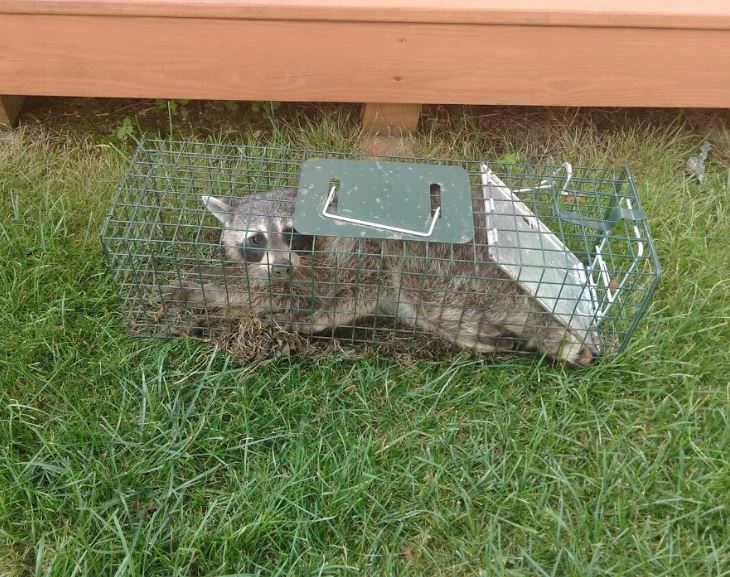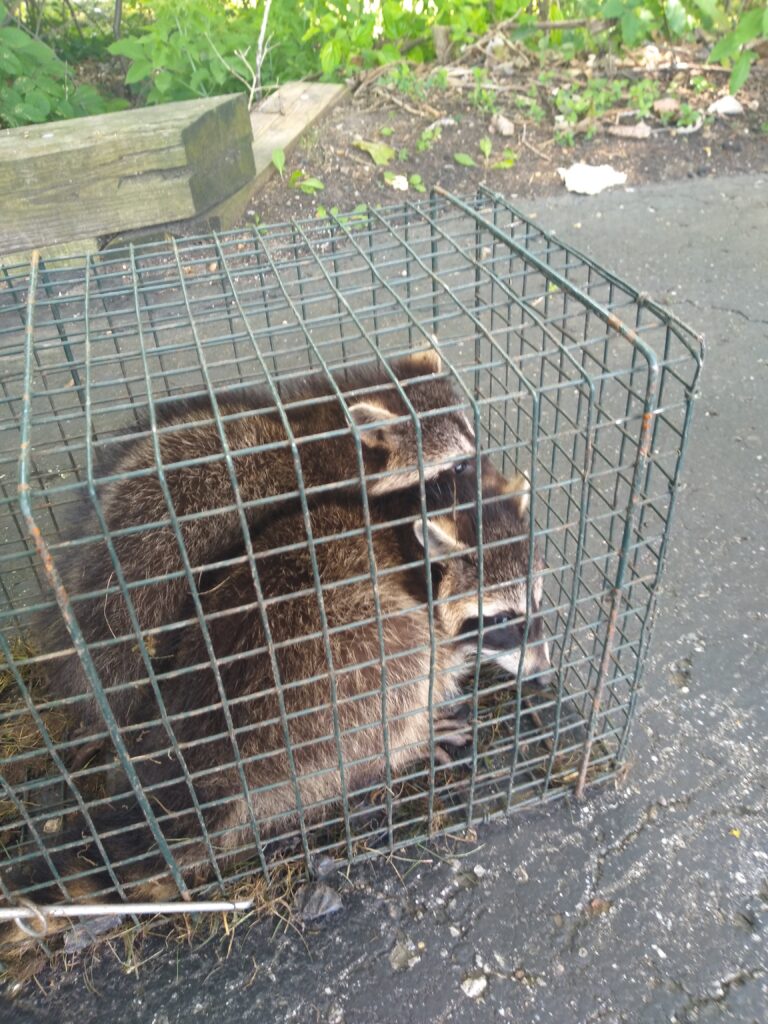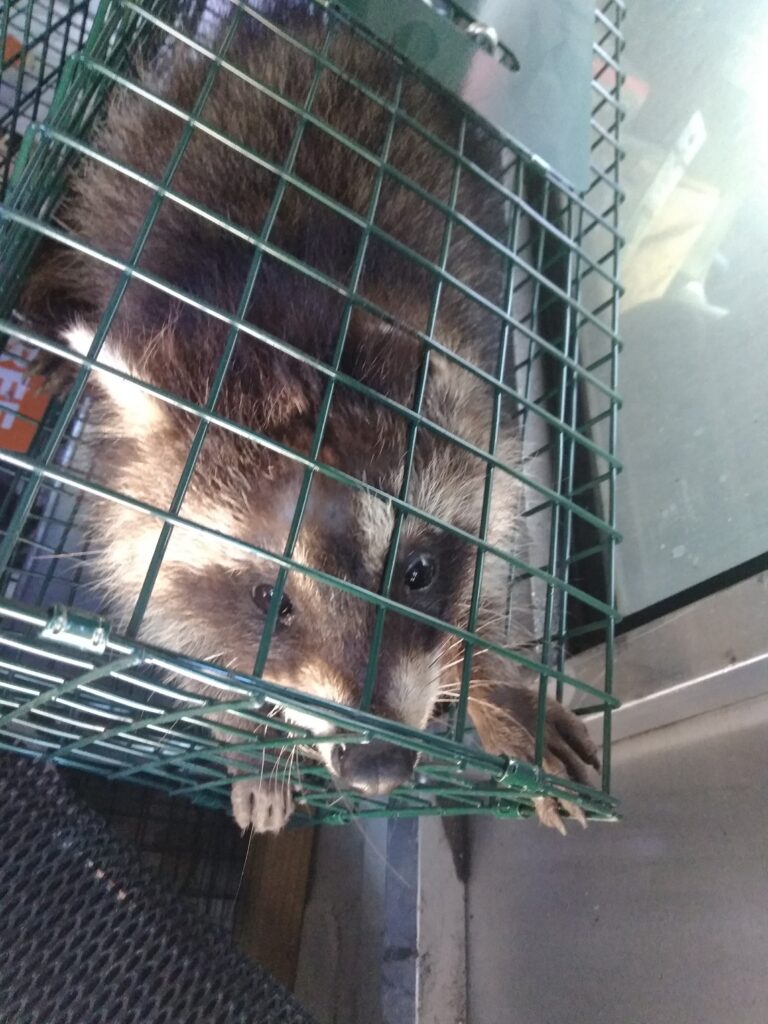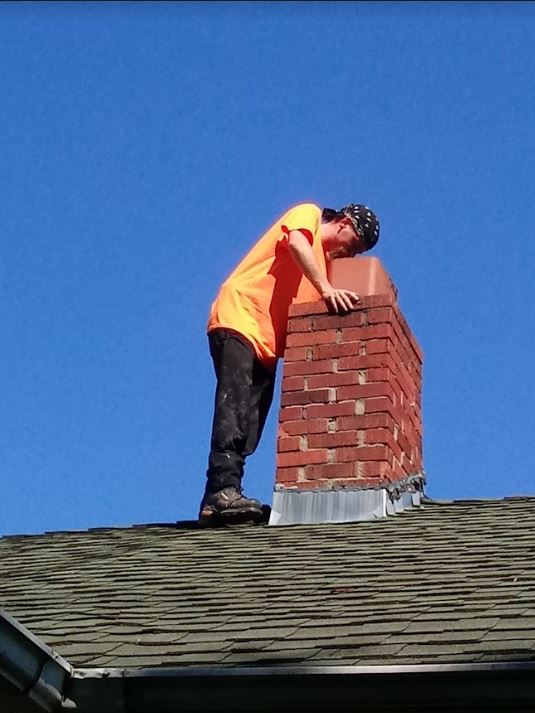GET RID OF RACCOONS ONCE AND FOR ALL
Why Do Raccoons Live In Homes? Where Will They Infest?
Raccoons will live virtually anywhere. This includes your home. Because raccoons have lived in urban areas for so long, they no longer fear humans. This makes the problem worse for you because it means that they won’t hesitate to make their way into your home. Your home, unfortunately, is the perfect place for raccoons to live. This is worsened if you leave dog food out or have outdoor trash cans as this will provide raccoons with a food source.
Raccoons prefer to live in warm, dry, and sheltered locations. Because they’re nocturnal, they will also prefer to live in places where it’s nice and dark. Raccoons’ favorite places to make their dens, as far as your home goes, is the crawl-space or attic. Raccoons are more likely to live inside of your crawl-space because it’s a much more accessible location for them. They won’t hesitate to use their incredible climbing skills to scale trees and gain access to your roof and crawl into your attic.
Why Should I Have Raccoons Removed?
Raccoons may appear cute and cuddly, but they are still wild animals. Furthermore, they are known for being highly aggressive. Raccoons won’t hesitate to strike at you if they feel cornered. Raccoons can cause a lot of harm to even an adult due to their size. If they were to attack a pet, a child, or an older family member, they could potentially cause injuries that would require a hospital visit.
Not only are they dangerous, but raccoons are also extremely destructive, look at the damage they can cause. They are known to rip apart pipes, insulation, drywall, and wood. They also chew through wiring, making them a major fire risk. Having a raccoon infestation that goes without being dealt with can potentially result in thousands of dollars in structural damage. If you find yourself with a raccoon infestation, it’s imperative that you remove it as fast as possible. With that being said, how exactly do we go about removing a raccoon from your home?

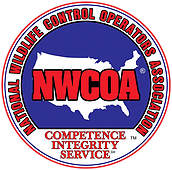
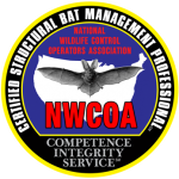

How Do We Remove A Raccoon?
The staff at Frank’s Wildlife Removal follows a process that is generally used with all of our raccoon removal projects. This is just a general outline and is prone to change depending on the situation.
Finding Their Home – Inspection
Before we’re able to move forward with the removal process, our team must locate where the raccoon is living. This is done during the inspection, where we will inspect the entirety of your home to locate exactly where the raccoon is. Frank’s Wildlife Removal performs in-depth inspections where we look through the entirety of your home for the location where the raccoon is living. We will determine whether or not the raccoon has kits, as well.
Removing The Raccoon – Removal And Prevention
The removal process begins with determining the specifics of the scenario. If we discover that the raccoon has had kits, we will plan the process based around the kits. If there is just one adult raccoon, the plan will be based on the single raccoon. As you can see, the plans that we use are prone to change. When we do remove the raccoon, we prioritize its safety. We will never use inhumane methods of removal. We will also never release an injured raccoon into the wild. If the raccoon has young, it will be reunited with them. We will never separate families.
Making Your Home Safe – Cleaning Up
After the raccoon is removed and the situation is deemed safe, our team will clean up the location where the raccoon was living. This is an extremely important aspect of the process as it ensures that your home is safe and livable. We will inspect the location where the raccoon previously lived to ensure that there are no hazards to your health or safety. We will also expect the extent of damage that the raccoon caused and determine what steps should be taken next. During this step, we also make your home safe from future infestations.
If you live in Michigan and struggle with a raccoon infestation, give Frank’s Wildlife Removal a call today at (810) 691-4967!
How to Get a Raccoon Out of Your Home
Raccoons, although very intelligent and curious, can be very destructive pests. They are nocturnal mammals that spend most of the day sleeping or resting in the hollows of trees or dens. A raccoon invasion is best avoided because of the damage that raccoons can cause to your home.
They can cause severe damage to insulation, electrical, and ventilation systems, which could lead to fire, water, and mold damage. This article will discuss the various methods you can use to get a raccoon out of your home.
Use a raccoon trap
There are several types of raccoon traps that you could use to remedy a raccoon invasion. You can use a live or “restraining” trap. A live trap is designed to trap a raccoon and keep it alive until it can be safely dispatched or translocated.
Some examples of live traps include cage traps, foothold traps, and snares.
Lethal traps (e.g., body traps and deadfall traps) are designed to kill raccoons quickly upon capture.
Lethal traps are considered inhumane and are heavily regulated in some jurisdictions.
Use raccoon repellent granules
Raccoon repellent granules can be used to get raccoons out of your home.
They are a natural and effective option that can help you get rid of raccoons. Raccoon repellent granules are especially effective because raccoons hate the scent as it disturbs their sensitive noses.
The granules are a powerful sense and taste repellent that can be used to drive raccoons out of your home.
Use an ultrasound raccoon repellent
Ultrasound animal repellents are a humane method of getting rid of raccoons. Loud sounds, especially when they are sudden, can scare away these intelligent nocturnal mammals. An ultrasound raccoon repellent will emit pre-recorded predator hunting sounds and other animal distress calls that will scare off raccoons.
Ultrasound raccoon repellents can emit sounds in specific frequencies that only raccoons (and other animals) can hear. In addition, some ultrasound raccoon repellents also have a very bright and flashing LED light that can scare off raccoons.
You could install an ultrasound raccoon repellent in areas of your home where you have discovered a raccoon trail.
Use a homemade raccoon repellent
Raccoons have very sensitive noses that they use to sniff out potential mates, predators, and food.
If you want to upset raccoons and get them out of your home, then you can use a homemade raccoon repellent. You can get a gallon of water and mix it with very hot cayenne pepper. Next, spray this water and pepper mixture in areas of your home in which you suspect raccoons may be hiding or frequenting.
This water and pepper mixture is very offensive to raccoons as it upsets their noses and sense of smell.
Use rodent repellent trash bags
One of the best ways to get rid of raccoons is finding out what raccoons hate and then using your discovery against the nocturnal pests.
The use of rodent repellent trash bags is one method you can use to get rid of raccoons.
Raccoons spend their nights hunting for food, and they find trash cans particularly attractive.
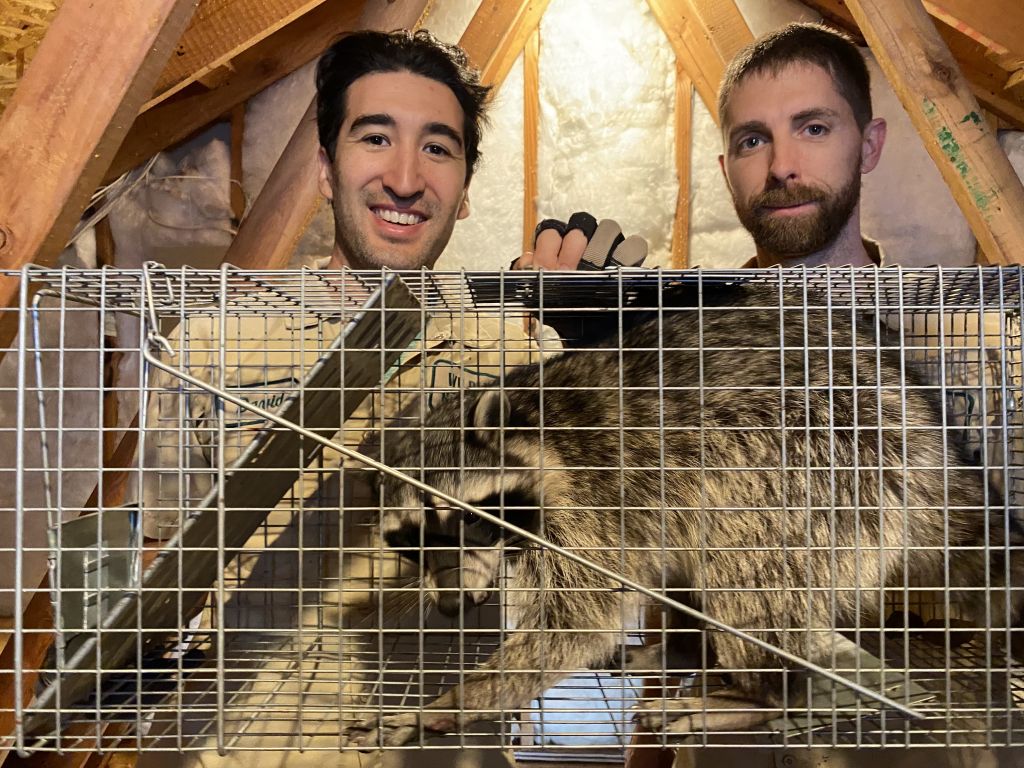
How to Get Raccoons Out of The Attic
Let’s face it; raccoons can be a severe nuisance. Left unchecked, they can do serious damage to your property and make your life a misery. Yes, they may be cute and furry, but that doesn’t mean they make good housemates. Visit atticraccoon.com to learn more about raccoons in the attic.
The first step to getting rid of a raccoon infestation is recognizing the signs that you may have a raccoon problem.
How to tell if you have raccoons in the attic
If you suspect you may have a raccoon problem, keep a lookout for these telltale signs…
- Hearing footsteps.
Raccoons are nocturnal, so if you’re constantly hearing what sounds like footsteps coming from your roof space at night, it could be raccoons coming and going from their nest.
- Spot droppings or smell urine.
Raccoons that are nesting in an area will set up latrines, so scat and strong urine smells are common. It can be hard to differentiate raccoon scat from other animals, so look for other signs to corroborate. Raccoon feces and urine can be harmful to humans and animals, so wear protective gear like gloves when cleaning.
- Damage and trails.
Check around your property for any damage leading to the attic, as well as dirty smudge marks. Raccoons can force their way into a space, so look for damaged panels and vents. Also, check the attic itself for any damage to insulation. Raccoons are creatures of habit, so look for well-worn paths around 10-12″ wide.
- Fingerprints and smudges.
Raccoons have small human-like hands, so they’ve been known to leave fingerprints in the dust around the attic. You may also be able to find smudged fingerprints along drainpipes and spouts around your property.
How to get raccoons out of your attic
Know that we know what we’re looking for; the next step is to decide the best course of action for removing raccoons from your attic. Begin by trying to ascertain whether there is a single animal or a mother with young. Listen out for chirping sounds, which indicate you have a raccoon young present.
There is a strong likelihood that a raccoon seeking a warm, cozy attic is setting up a nest to rear young. If you discover any young, do not try to remove them yourself. Call a wildlife professional to remove them, and who knows how to reunite a relocated raccoon with its young properly.
If you are absolutely sure you are dealing with a single raccoon, you can give some of these steps a try.
- Live Traps.
Live traps can be a fantastic, humane way of catching and relocating a bothersome raccoon. Be sure to check your state legislation before attempting to trap a live animal, as some states have legal requirements.
- Seal gaps and openings.
This may seem like an obvious step, but sealing up and access points to your attic can prevent an infestation in the first place. You can also install one-way doors, which would allow an animal inside to escape but would block re-entry to your property.
- Humane harassment.
Raccoons are very sensitive to light, noise, and sound. Using a combination of raccoon eviction fluid, strobe lighting, and a loud radio has been proved to be very effective in getting rid of unwanted guests. Try to set up your lights and radios around dusk, as raccoons are nocturnal and can become disorientated if left to wander during daylight.
If you suspect you have a raccoon infestation in your attic, our first recommendation will always be to call a professional. Raccoons often have young nearby and may attack if they feel their young are threatened.
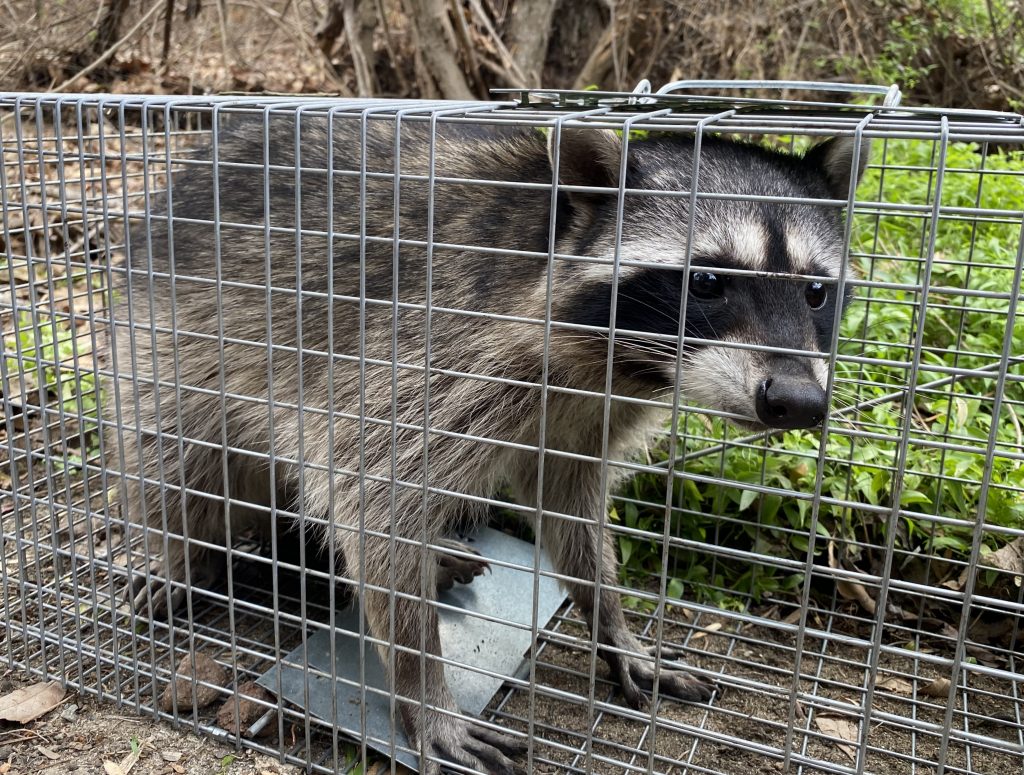
How to Prevent Raccoons From Your Backyard?
For many homeowners, raccoons have long since ceased being a cutesy animal you see on the Internet and very real, and menacing reality. Although raccoons aren’t really a threat to your personal safety (unless you count the many diseases they carry), they can wreak havoc in your yard, or even in your house.
So it’s important to learn all the do’s and don’ts, and how you can keep raccoons away from your backyard.
- Fence the yard.
This is probably the most obvious, the easiest way to deter raccoons and any other wild animal from bothering you. Simply installing a fence around your backyard can often be enough to keep wild animals off, and it has the unique benefit of working as a one-size-fits-all.
In other words, you’re not simply installing a fence to keep raccoons out. You’re installing it to keep everyone out. This can be an efficient way to protect your backyard, one that doesn’t require you to sacrifice other things on your property that may turn out to be common attractions (e.g. your garden patch, or a bird bath).
- Remove water sources.
A common reason why raccoons frequent human properties are that they are a readily available water source. Much like us, raccoons need to hydrate regularly, in order to thrive. So try to identify what that might be.
For some homes, the water source may be a damaged, dripping pipe, while for others, it may be the water bowl you left out for your pet. Similarly, bird baths or ponds might also constitute big attractions.
- Keep food sources to a minimum.
The other great big reason why raccoons are attracted to your property is, naturally, the food. Now, this comes in a wide array of options. It can mean fallen fruit from your trees. It can mean pet food bowls. It can mean bird feeders. Or of course, it can mean the ever-popular trash can.
So simply bringing in the pet food bowls overnight, picking up fallen fruit, and securing your trash cans (with elastic bands, or investing in sealable trash cans) can go a long way.
- Also, clean the trash cans.
Regardless if they’re sealed or not, trash cans tend to accumulate various juices and leftovers over time, which in turn leads to a certain unpleasant odor appearing. While this smell may simply be unpleasant for you, it is really tasty for raccoons and may be what’s attracting them to your home. So make sure you clean those trash cans regularly, to avoid smelly build-up.
- Turn on the light.
Raccoons are nocturnal creatures with infamously weak eyes, which fortunately for you, means that they have a deep dislike for bright lights. For some homeowners, it may be enough to simply leave the porch light on at night, while others may want to look into a light deterrent.
This is basically a device that is motion-activated, and that will light up whenever it senses movement around your backyard. It will effectively startle and discourage the raccoon from its scavenging mission.
- Try to deter them with smells.
Raccoons are sensitive, it is said, to certain smells. So in this sense, you may use your garden to your advantage. By planting cucumber or garlic, you can create a natural raccoon deterrent that will keep your garden patch safe from pillagers.
Speaking of smells, you may also want to use ammonia or vinegar to make a raccoon deterrent, and spray that on your crops. Last but not least, you could just try fencing your garden (or your whole property) to create an effective raccoon barrier.
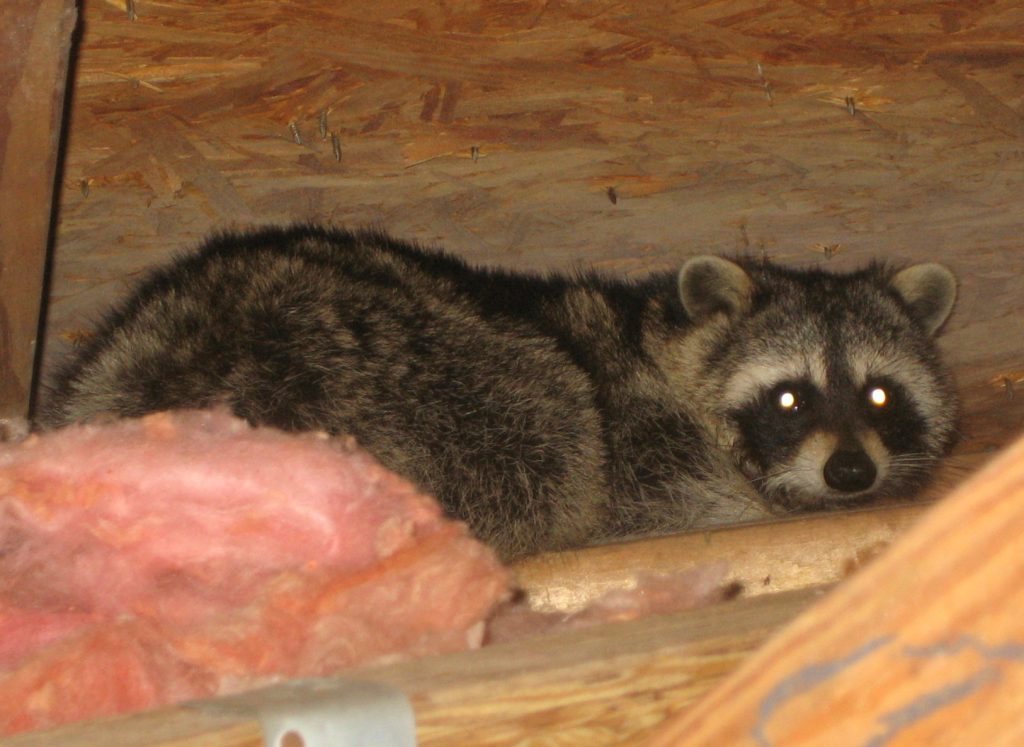
What Diseases Do Raccoons Carry?
While most people are scared of wildlife infestations because of a potential attack, most wild animals aren’t that likely to attack you. Basically, they’re likely to leave you alone, as long as you don’t bother them, largely because they’re scared of a confrontation themselves. So that’s good news for you…in a way. While raccoons most likely won’t lash out at you unless they feel they’ve got no other choice, their presence on your property still exposes you to a varied range of diseases, which is why you need to be careful and address an infestation quickly.
The best way to handle a raccoon infestation is to call us at New Journey Pest Control, to arrange the speedy removal of the nuisance animal. A professional wildlife removal service is the safest, most reliable choice for removing wildlife from your property, otherwise, you just risk spending a lot of effort in vain. Besides, attempting DIY removal can also put you in close proximity to the raccoon who, although fairly docile and non-threatening while left alone, won’t hesitate to scratch or bite you, if you’re threatening him.
So all in all, it’s best to leave that to the professionals.
It’s also important to be informed about wildlife, and what risks they may pose to your health and safety. This brings us to our title question.
What diseases do raccoons carry?
The number one risk of having raccoons on your property is that they may expose you to serious bacteria and illness. Even if they don’t pose a direct threat to your health and safety, their presence may be dangerous to your pets, since some illnesses are more easily transmitted from one animal to another.
What diseases, exactly?
One of the most common diseases encountered in raccoons is leptospirosis, which is a bacterial disease created by the Leptospira bacteria. Most commonly, leptospirosis is transmitted when urine or fecal matter of the infected animal contaminates the food and water supply.
Tularemia is another common complaint with raccoons, which may lead to painful ulcers. There are several ways in which human beings can become infected with tularemia, including exposure to a contaminated water source, or direct skin contact with an infected animal. Tularemia is a particularly sneaky disease since it can also be transmitted through the bites of ticks and deer flies.
Another disease that a raccoon may expose you to is, of course, rabies. This is a very serious danger and should be treated in all seriousness, both for the sake of yourself and your pet. In pets, in particular, infection with rabies may go unnoticed by the owner, as the bite may not be evident. This sometimes causes a significant delays between infection and treatment, which can have fatal consequences for the animal.
Canine distemper is a common virus infection that occurs in raccoons. It’s worth noting that since the neurological symptoms are similar, canine distemper can sometimes be mistaken for rabies.
Lastly, another big concern when it comes to raccoons is toxoplasmosis, which is a parasitic disease and is often associated with immunosuppression (common with canine distemper). It’s the result of infection with the Toxoplasma gondii parasite, which is extremely common, thus making it an extremely common infection.
While fairly easy to treat in most cases, left untreated, toxoplasmosis can lead to blindness, as well as life-threatening seizures.
This, along with all the other diseases that a raccoon exposes you to are serious and should be treated as such. If you spot a raccoon on your property, keep your distance, and keep your pets away, while you call for a professional wildlife removal expert.
GET FAST QUOTE
Franks Wildlife SERVICES
Service Areas

